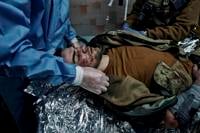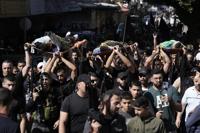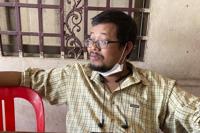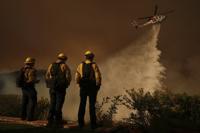MOUNT ARAFAT, Saudi Arabia (AP) — Following the footsteps of prophets beneath a burning sun, more than 1.83 million Muslims from around the world congregated Saturday at a sacred hill in Saudi Arabia for worship and reflection amid a sweltering heat.
The ritual at Mount Arafat, known as the hill of mercy, is considered the peak of . It is often the most memorable for pilgrims, who stand together asking God for mercy, blessings, prosperity and good health. The hill is about 20 kilometers (12 miles) southeast of Mecca.
Thousands of pilgrims walked here through the predawn darkness. On the slopes of the rocky hill and the surrounding area, many raised their hands in worship with tears streaming down their faces.
“For sure it is something great. It is the best day for Muslims during the year, and the best feeling that anyone can experience,” Hussein Mohammed, an Egyptian pilgrim, said as he stood on the slopes at dawn. “It is the best place for anyone hoping to be (here) on this day and at this moment.”
It’s believed that Prophet Muhammad delivered his final speech, known as the Farewell Sermon, at Mount Arafat 1,435 years ago. In the sermon, the prophet called for equality and unity among Muslims.
Ali Osman, a Spanish pilgrim, was overwhelmed, as he stepped down from the hill. He said he felt that he gained spiritual and physical strength at the sacred site.
“The place, thank God, (gives) very good energy,” he said. “I came here, thank God. It is my first time. I hope to come again in the future.”
Hajj is on earth. The rituals officially started Friday when pilgrims moved from Mecca’s Grand Mosque to Mina, a desert plain just outside the city.
More than 1.83 million Muslims performed Hajj in 2024, Saudi Hajj and Umrah Minister Tawfiq bin Fawzan al-Rabiah said in a briefing. That's slightly less than last year’s figures when 1.84 million made the rituals.
The pilgrimage is one of the . All Muslims are required to make the five-day Hajj at least once in their lives if they are physically and financially able to do so.
The rituals largely commemorate the Quran’s accounts of Prophet Ibrahim, his son Prophet Ismail and Ismail’s mother Hajar — or Abraham and Ismael as they are named in the Bible.
This year’s Hajj came against the backdrop of the , which pushed the Middle East to the brink of a regional conflict.
Palestinians in the Gaza Strip weren't able to travel to Mecca for Hajj this year because of in May, when Israel extended its ground offensive to the city on the border with Egypt.
Staving off potential protests or chants about the war during the Hajj, Saudi authorities said they won’t tolerate politicizing the pilgrimage.
In his sermon Saturday at the sprawling, six-minaret Namera mosque in Arafat, Saudi cleric Maher Bin Hamad al-Mu’wiqly, also cautioned about politicizing Hajj.
However, he urged pilgrims to pray for the Palestinians who have been “harmed and hurt by their enemy” that killed them, and “deprived them of what they need from food, medicine and clothing.” He didn’t mention Israel in his sermon.
The war has killed more than 37,000 Palestinians there, according to Gaza health officials, while hundreds of others have been killed in Israeli operations in the West Bank. It began after Hamas-led militants attacked Israel on Oct. 7, killing about 1,200 people and taking around 250 hostage.
The time of year when the Hajj takes place varies, given that it is set for five days in the second week of Dhu al-Hijjah, the last month in the Islamic lunar calendar.
Most of the Hajj rituals are held outdoors with little if any shade. When it falls in the summer months, temperatures can soar to over 40 C (104 F). The Health Ministry has cautioned that temperatures at the holy sites could reach 48 C (118 F) and urged pilgrims to use umbrellas and drink more water to stay hydrated.
Most of the pilgrims at Mount Arafat carried umbrellas, while others sat in the shade. Many were seen splashing water on their faces and bodies. And, as at Mina and the Grand Mosque, cooling stations on the roads leading to the hill and in its surrounding areas sprayed pilgrims with water to help fight the heat, which had already climbed to 47 C (116.6 F) at Mount Arafat, according to Saudi metrological authorities.
Saudi Health Minister Fahd bin Abdurrahman Al-Jalajel told The Associated Press that more than 150 pilgrims have been treated for heat exhaustion. He urged pilgrims to drink water and carry umbrellas as they perform Hajj’s rituals.
As pilgrims perform their worships, contracted migrant cleaners with lime-green jumpsuits were collecting empty water bottles and other trash around Mount Arafat.
At sunset Saturday, pilgrims left Mount Arafat, heading to a nearby site known as Muzdalifa to collect pebbles that they will use in the symbolic stoning of pillars representing the devil back in Mina. Many walked, while others were transported there by buses.
Pilgrims then return to Mina for three days, coinciding with the , when financially able Muslims around the world slaughter livestock and distribute the meat to poor people. Afterward, they return to Mecca for a final circumambulation, known as Farewell Tawaf.
Once the Hajj is over, men are expected to shave their heads, and women to snip a lock of hair in a sign of renewal. Most of the pilgrims then leave Mecca for the city of Medina, about 340 kilometers (210 miles) away, to pray in Prophet Muhammad’s tomb, the Sacred Chamber. The tomb is part of the prophet's mosque, which is one of the three holiest sites in Islam, along with the Grand Mosque in Mecca and the Al Aqsa Mosque in Jerusalem.
___
Associated Press religion coverage receives support through the AP’s with The Conversation US, with funding from Lilly Endowment Inc. The AP is solely responsible for this content.










































